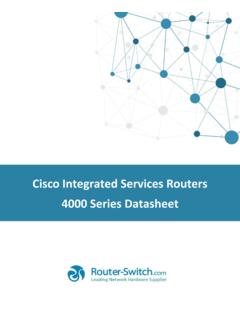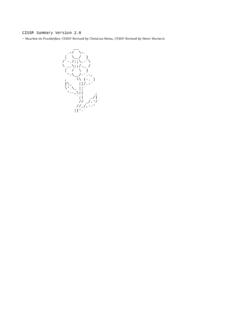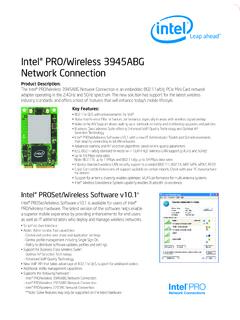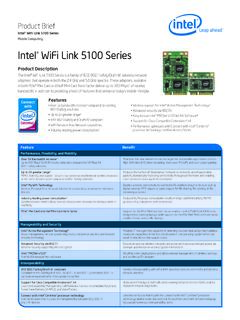Transcription of Deploying OAuth with Cisco Collaboration Solution …
1 2018 Cisco and/or its affiliates. All rights reserved. This document is Cisco Public. Page 1 of 24 White Paper Deploying OAuth with Cisco Collaboration Solution Release Authors: Bryan Morris, Kevin Roarty ( Collaboration Technical Marketing) Last Updated: December 2017 This document describes the new OAuth deployment mode available with Unified Communications Manager, IM and Presence Server, Cisco Jabber and Expressway. Introduction This whitepaper has been created to help administrators understand the support for the OAuth standard in Cisco s Collaboration Solution .
2 The reader will learn what OAuth is, the benefits of OAuth for their organization, what is required to use OAuth and the user experience OAuth delivers for Cisco Jabber users. What is OAuth OAuth is an authorization protocol. It is an open standard defined by the IETF OAuth Working group which was originally released in 2007. In 2010 OAuth was released as RFC6749 which is the current version of the standard. OAuth allows an end user to authorize an application to gain access to a third party service without sharing their credentials with the application. To grant access to a third party service a user authorizes an OAuth server via authentication to issue OAuth tokens to the third party application.
3 The application can now present the OAuth token to access a protected resource rather than user credentials. OAuth tokens will expire after a period of time thus limiting the time the 3rd party application can access the resource. In some implementations OAuth can provide a method to refresh an expired token to provide continued access to information or a service. Printed in USA CXX-XXXXXX-XX 10/11 2018 Cisco and/or its affiliates. All rights reserved. This document is Cisco Public. Page 2 of 24 There are multiple OAuth flows, this diagram provides a summary of the flow used by Unified CM.
4 1. Resource server redirects client to authorization server 2. Resource owner required to authenticate to grant access 3. Client authorized to access resource server How does OAuth Work OAuth is heavily used on the Internet today. If we consider an example, it is a common scenario for an end user to authorize a 3rd party website (such as a travel site) to access information on a social media site (such as Facebook or Twitter). In this case the user typically clicks an allow access to social media button to authorize access to information (such as a contact). This will result in a web page for the social media site to be opened.
5 The user will need to confirm their identity ( authentication ) and maybe approve what information can be accessed. On a successful authentication the social media site allows a n access token to be issued to the 3rd party using OAuth . The key benefit here is the user never gave their authentication credentials to the 3rd party. These were kept secret between the social media site and the user. The token can be defined so it has a limited scope, for example it can be used to view contacts on the social media site but doesn t allow to post information. Finally the token can be valid for a predefined duration.
6 The OAuth protocol is a framework specification. OAuth can be compared to a toolbox of authorization functions. The OAuth standard defines a protocol Flow where defined Roles take part in the authorization process. The OAuth roles are: Resource Owner (End User) Client ( Cisco Jabber/User Agent) Resource Server ( Unified CM) Authorization Server ( Unified CM OAuth ) 2018 Cisco and/or its affiliates. All rights reserved. This document is Cisco Public. Page 3 of 24 When using the Cisco Jabber UC client we need to access multiple services offered by the Collaboration infrastructure.
7 We need to access configuration information, instant message service, call control and voicemail. If the Collaboration infrastructure is configured to use OAuth , the Jabber client only has to authenticate once to get an OAuth token. Jabber will then use that token to access all these services. Only when the token expires do we need to authenticate again. This provides a more secure Solution as the Jabber application never needs to know the user password. Jabber is also only authorized to access the services it needs using the token. When talking about OAuth it is important to understand the difference between authorization and authentication .
8 OAuth is a standard which supports authorization. A user must be authenticated before they can be authorized. Before granting authorization the OAuth authorization service will normally call or redirect to an authentication service such as a user database, LDAP directory or SAML based Identity Provider (IdP). authentication authentication is the process of confirming a person (or thing s) identity. Traditionally this is using a username and password but could use a certificate or other proof of identity. Increasingly modern systems require multi-factor authentication where multiple proofs of identity are required.
9 authentication doesn t define what a user can do but just that they are the correct person. We can compare this to a hotel check-in: when you arrive at the hotel they will ask for proof of identity. This could be a passport, driving license or other document that can confirm your identity. Authorization Authorization is the process of defining access rights or privileges to an entity. If we again compare this to a hotel check-in, the hotel will authorize you to access a hotel room by providing you with a room key once they have confirmed your identity. The room key may provide you with access to additional facilities in the hotel such as the gym or swimming pool.
10 You are not required to prove your identity again once you have the room key. Furthermore, anybody owning the room key can get access to the room using that key. OAuth Flows An authorization request is a set of interactions between the OAuth roles. OAuth provides different interaction models or Flows depending on the operating environment. OAuth provides the following protocol flows: Resource Owner Password Credentials Flow Client Credentials Flow Authorization Code Grant Flow Implicit Flow The OAuth specification makes recommendations for when a developer should use each of these flows.














